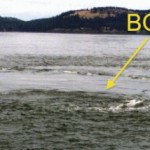
I’m reporting this week from the Ocean Sciences Meeting, the annual meeting of the American Society for Limnology and Oceanography (ASLO) and The Oceanographic Society (TOS). The first session I went to this morning was on Marine Predator hotspots. There were some interesting talks on megavertebrate distributions, diving behavior and habitat provisioning.
D.M. Palacios presented an interesting talk about is groups work on tagging and tracking albatross post-breeding habitat provisioning. They are looking at 2 species who breed together in the tropical Pacific: the Laysan and the Black-footed albatrosses. But what happens in the post-breeding season? Laysan albatrosses appear to be aggregated in an east-west central tropical distribution, while the Black-footed albatross was concentrated north of the breeding islands. Its interesting that the Laysan albatross, the smaller of the two, appears to travel farther in the postbreeding season.
Dan Costa and N. Sarkar both presented research on seals. Costa showed some results indicating habitat provisioning in three species of co-occurring seals: Crab-eater, Weddell and southern Elephant seals. The crab-eater and weddell seals were shallower divers (60-90 m) for shorter durations (3-12 min.) while the elephant seal dove much deeper (357 m) for longer periods (22.4 min.) and had the farthest range at about 5000 km. What is interesting is that the distance per day was about the same at around 20 km per day for the elephant and weddell seals (about 15 km/day for the crab-eater) despite the elephant seal ranging twice as far as the other 2. Sarkar presented finding on what northern elephant seals are doing around eddies in the Gulf of Alaska. She tracked the seals and found that they were spending roughly 22% of their time in eddies, with durations stayed in an eddy of up to 2 weeks. Thus, they appear to prefer staying in eddies. Since elephant seals dive at an angle and not straight down, she plans to figure out how to measure the angle they dive and how that relates to the depth-temperature profile. I’m looking forward to seeing hose results.
M.E. Baumgartner presented findings on the springtime foraging ecology of north Atlantic right whales. They seem to consistently follow the depth of their prey, the small copepod Calanus. In the summer they are concentrated at a depth of around 150 m and the whales make very periodic dives to the exact depth of the copepods. But in the springtime, the vertical position of Calanus is variable being concentrated anywhere near the surface (10-12 m deep) to 50+ m down almost at the seafloor. Through tagging the whales, he documented that they can forage at or near the seafloor which is a new finding. Additionally, he showed evidence that the variability of the diel-vertical migration (i.e. movement through the water column corresponding with day/night cycles) of the copepods drives the whales variability in springtime feeding.






There’s a few RWU undergrads running around ASLO un-chaperoned – they’re presenting posters on marine viruses and are supposed to be absorbing as much of this experience as they can (as well as gathering some reconnaissance about some flow cytometers we’re trying to decide between). If you see them, make sure they’re not sleeping during any of the sessions or sneaking out to Disney. Thanks! :)
We’ve got a number of attendees (grad students and profs) from Nova Southeastern’s Oceanographic Center there as well — wish I could join everyone, but I’ve fish-related fieldwork to do this week.
Just a note that us Geology folks are here too….it is also co-sponsored by AGU. There have been some fantastic talks on Deltas and Sea-level, nearshore morphology, carbon export from rivers and even a talk on the Grand Canyon Experimental Floods .